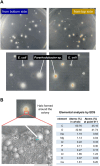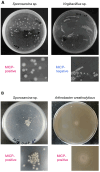In situ mineral formation on a plate for direct and efficient screening of bacteria suitable for biocementation
- PMID: 40436900
- PMCID: PMC12119853
- DOI: 10.1038/s41598-025-01350-2
In situ mineral formation on a plate for direct and efficient screening of bacteria suitable for biocementation
Abstract
Microbially-induced carbonate precipitation (MICP) using a urea-hydrolyzing enzyme (urease) is a next-generation, environmentally friendly cementation technique. The isolation of excellent urease-producing bacteria for MICP is essential for establishing this technique. We have demonstrated a highly effective screening method for identifying promising bacteria suitable for MICP. In our selective plate, MICP-positive bacteria formed a CaCO3 halo around the colony on the plate, which was clearly distinguishable. Furthermore, we found that the CaCO3 formation activity of each bacterium was strongly correlated with the strength of the solidified sand samples. This technique is a novel approach for screening bacteria suitable for biocementation or MICP.
Keywords: Biocementation; Biomineralization; Carbonate precipitation; High-throughput screening; Selective plate.
© 2025. The Author(s).
Conflict of interest statement
Declarations. Competing interests: The authors declare no competing interests.
Figures






Similar articles
-
Insights in MICP dynamics in urease-positive Staphylococcus sp. H6 and Sporosarcina pasteurii bacterium.Environ Res. 2023 Oct 1;234:116588. doi: 10.1016/j.envres.2023.116588. Epub 2023 Jul 7. Environ Res. 2023. PMID: 37423368
-
Halotolerant, alkaliphilic urease-producing bacteria from different climate zones and their application for biocementation of sand.World J Microbiol Biotechnol. 2013 Aug;29(8):1453-60. doi: 10.1007/s11274-013-1309-1. Epub 2013 Mar 26. World J Microbiol Biotechnol. 2013. PMID: 23529354
-
Synergistic biocementation: harnessing Comamonas and Bacillus ureolytic bacteria for enhanced sand stabilization.World J Microbiol Biotechnol. 2024 Jun 3;40(7):229. doi: 10.1007/s11274-024-04038-3. World J Microbiol Biotechnol. 2024. PMID: 38825655 Free PMC article.
-
Influencing factors on ureolytic microbiologically induced calcium carbonate precipitation for biocementation.World J Microbiol Biotechnol. 2022 Dec 28;39(2):61. doi: 10.1007/s11274-022-03499-8. World J Microbiol Biotechnol. 2022. PMID: 36576609 Free PMC article. Review.
-
Insights into the Current Trends in the Utilization of Bacteria for Microbially Induced Calcium Carbonate Precipitation.Materials (Basel). 2020 Nov 5;13(21):4993. doi: 10.3390/ma13214993. Materials (Basel). 2020. PMID: 33167607 Free PMC article. Review.
References
-
- Habert, G. et al. Environmental impacts and decarbonization strategies in the cement and concrete industries. Nat. Reviews Earth Environ.1, 559–573. 10.1038/s43017-020-0093-3 (2020).
-
- Whiffin, V. S., van Paassen, L. A. & Harkes, M. P. Microbial carbonate precipitation as a soil improvement technique. Geomicrobiol. J.24, 417–423. 10.1080/01490450701436505 (2007).
-
- De Muynck, W., De Belie, N. & Verstraete, W. Microbial carbonate precipitation in construction materials: A review. Ecol. Eng.36, 118–136. 10.1016/j.ecoleng.2009.02.006 (2010).
-
- Mwandira, W. et al. Solidification of sand by Pb(II)-tolerant bacteria for capping mine waste to control metallic dust: case of the abandoned Kabwe mine. Zambia Chemosphere. 228, 17–25. 10.1016/j.chemosphere.2019.04.107 (2019). - PubMed
-
- Gowthaman, S., Mitsuyama, S., Nakashima, K., Komatsu, M. & Kawasaki, S. Biogeotechnical approach for slope soil stabilization using locally isolated bacteria and inexpensive low-grade chemicals: A feasibility study on Hokkaido expressway soil, Japan. Soils Found.59, 484–499. 10.1016/j.sandf.2018.12.010 (2019).
MeSH terms
Substances
Grants and funding
LinkOut - more resources
Full Text Sources

